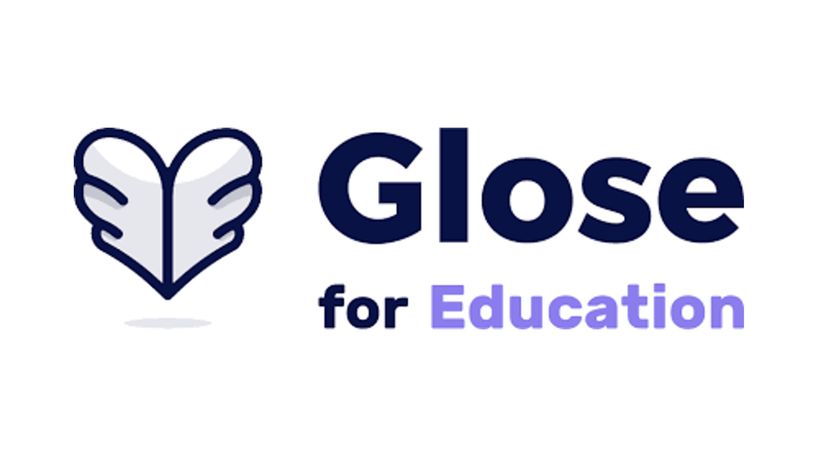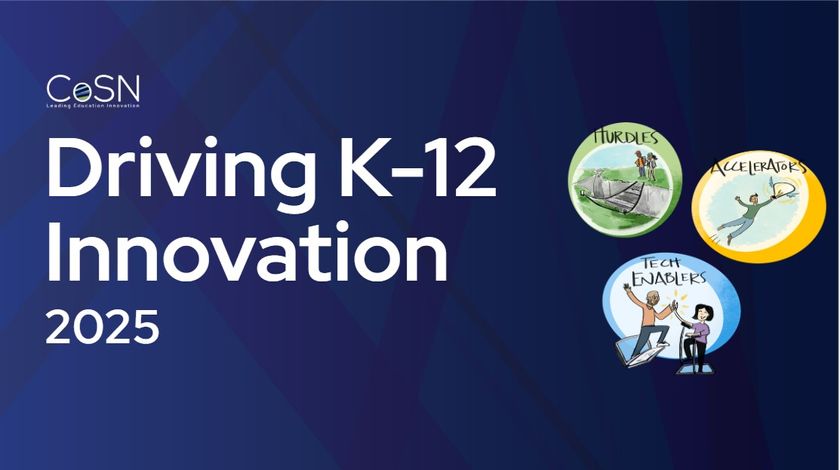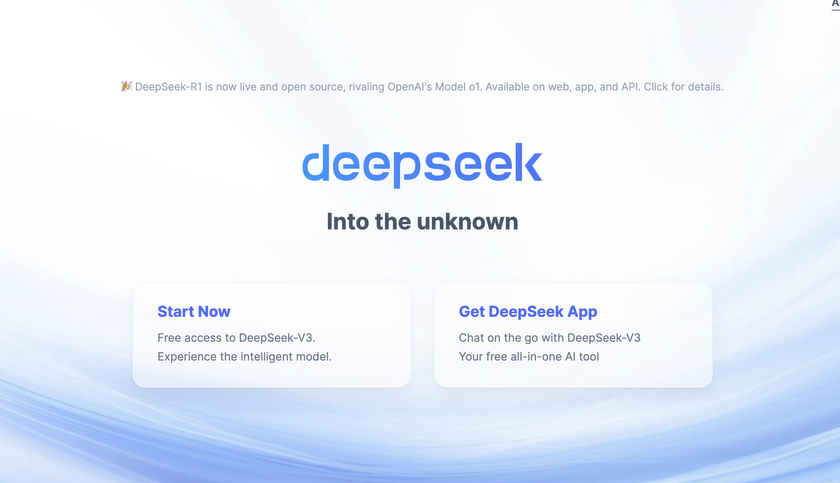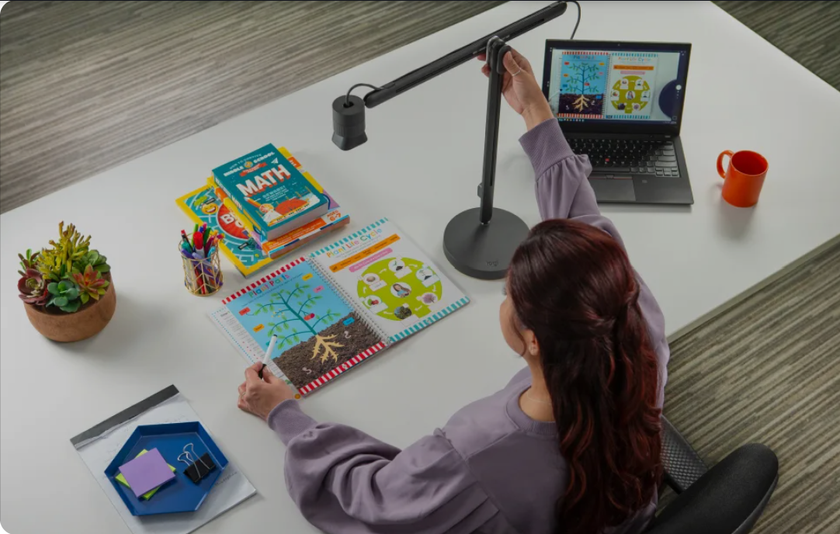T&L News(155)
Week of: November 17, 2008
- Web Suites Go Head to Head
T&L reviewer Carol Holzberg compares Adobe Creative Suite 4: Web Premium to Microsoft Expression Studio 2. - Whats New Online
K12 Alerts: School administrators can schedule, send, and track real-time personalized messages to thousands of parents, staff, and community members in seconds via work and home emails, and text to cell phones. - Tech & Special Needs
In addressing special education needs, many teachers struggle to find effective tools. Terri Grundy, Occupational Therapist and Assistive Technology Consultant, acknowledges the difficulties of addressing individual students' needs in addition to following the regular, demanding school curriculum. - Sites We Like
ClassScene: This free online community allows student to create, share and store memories from the school year, online with other students from same schools. - Win a Classroom Jeopardy!
Through December 29, 2008, log on to http://www.etacuisenaire.com/classroomjeopardycompetition each week to test your knowledge in math, science and literacy and win great classroom prizes!
- Microsoft Corporation
- Microsoft Expression Studio 2 featuring:
- Expression Web 2-WYSIWYG graphical Web site design and Web page construction
- Expression Blend™ 2-Composite vector and bitmap images, video, audio, and rich text to create a host of custom vector elements or combine elements such as buttons, scroll bars, list boxes, menus, radio buttons, tree views, sliders, and check-boxes into compound controls.
- Expression Design 2-Create both vector and bitmap graphics
- Expression Media 2-Organize and manage visual catalogs of digital assets including images, video, PDF files and fonts. (This is the only application that currently runs on both Mac and Windows PCs.)
- Expression Encoder 2-Encode video content for output as Silverlight-ready WMV (Windows Media Video) content.
- Adobe Corporation
- Adobe Creative Suite 4: Web Premium featuring:
- Dreamweaver CS4-Create Web sites and pages with this WYSIWYG editor
- Flash CS4 Professional-Create animations and interactive Web content
- Photoshop CS4 Extended-Edit, manipulate and analyze 2D and 3D images; paint directly on 3D models; convert 2D images to 3D objects
- Illustrator CS4-Create and edit vector graphics
- Fireworks CS4-Create, edit, and optimize Web graphics
- Acrobat 9 Pro-Create, edit, organize, and manage PDF content
- Soundbooth CS4-Create and edit audio content
- Contribute CS4-Delegate content publishing, giving users permission to edit specific Web content without compromising the rest of your Web site.
- Adobe Bridge CS4-Organize and view digital assets in electronic catalogs
- Adobe Device Central CS4-Preview and test content for mobile devices
- Version Cue CS4-Store projects on a virtual server, then centrally manage those shared projects and common files
Description:
Classroom life has gotten mighty Web-oriented these days! No matter what the instructional activity, teachers and students often find themselves heading to the Internet to retrieve information, access Web-based resources, and take advantage of interactive tutorials. But what about producing Web content? If your school or classroom has a Web site, what tools and applications do you and your students use for Web page composition and content editing?
Recently, both Microsoft and Adobe released major upgrades of their powerhouse Web Design toolkits. Microsoft's Expression Studio 2 runs primarily under Windows and consists of five applications (see above). Expression Web 2, the suite's flagship Web editor, comes with several ready-made templates that students can use to build their first Web site. These templates provide stylish layouts with boilerplate text and image placeholders, as well as navigation bars for consistent movement from one page to the next.
Adobe's Creative Suite 4: Web Premium, on the other hand, is available both for Windows (XP with SP2 or Vista with SP1) and Macintosh (Power PC, G5 or Intel processor running OS X 10.4.11 or later). It features 11 applications, including three typically bundled with other Adobe CS4 suites, i.e., Adobe Bridge, Adobe Device Central and Adobe Version Cue. Unlike Microsoft Expression Web 2, however, Dreamweaver CS4 does not include those colorful site-ready templates complete with navigation bars. It does offer several ready-made sample blank pages, frame layouts and CSS design files to give users a head start in project design, but lacks the colorful Starter Page samples that shipped with Dreamweaver CS3.
Cost of doing Web Business
Currently, high schools can get the Microsoft Expression Studio 2 suite at no charge through Microsoft High School Academic Alliance. Microsoft also bundles Visual Studio Standard 2008 as part of this pilot program. Membership in the alliance runs for a year. High School instructors interested in using the suite in Web Design courses can take advantage of the free Expression Web curriculum aligned with NETS (National Education Technology Standards) that Microsoft provides, complete with essential questions, lesson plans, rubrics, and tutorials. Additional tutorials and other helpful Web design resources can be downloaded from the Microsoft Expression Web site.
Tech & Learning Newsletter
Tools and ideas to transform education. Sign up below.
Adobe charges for CS4: Web Premium, but schools can take advantage of academic pricing and volume licensing options. Adobe also offers a free year-long companion standards-based Digital Design curriculum with unit and activity step-by-step tutorials, reproducible student materials, presentations, and some media assets. Teachers can download these resources and use them in their Web design courses. Adobe Digital Design instructional materials are aligned both to the International Society for Technology in Education (ISTE) National Educational Technology Standards (NETS) for Students (2007) and Adobe's new Certified Associate Web Communication and Rich Media Communication objectives.
Should You Upgrade?
Both Expression Web Studio and Adobe's latest Web Design Suite have several new features that make upgrading worthwhile. For example, Adobe Web Premium includes an overhauled interface with a more streamlined workspace regardless of application, plus tighter integration among Photoshop, Illustrator, Dreamweaver and Fireworks applications. Dreamweaver CS4 has several new features making it easier for Web design newbies to create and manage Web content and CSS styles. Just the new Live View option alone with its interactive code editing is a huge improvement because designers can preview a page under construction in a simulated browser while still being able to implement changes in code view. Add to this the modifications in the program's Property Inspector which splits text editing options into CSS (Cascading Style Sheets) vs. HTML formatting and even CSS-challenged folk like me can easily create CSS targeted rules to apply to the open page or other pages in the site.
Which Suite Should You Choose?
Schools and districts that have already standardized on Adobe applications or Macintosh should upgrade to Adobe CS4: Web Premium if funds permit. The suite incorporates new animation tools, fast switching from Photoshop to Illustrator to Flash to Fireworks, enhanced Web authoring tools and much more. On the other hand, if your school or district is Windows-based and you want a less expensive way to integrate the latest Web design technologies into the curriculum, Microsoft Expression Studio 2 delivers top-quality, high-end tools for site construction, digital asset management and support for Adobe Photoshop and a more affordable price than Adobe CS4: Web Premium.
Suggested Reading:
Binder, Kate (2009). Sams Teach Yourself Adobe Photoshop CS4 in 24 Hours, SAMS, ISBN-13: 978-0-672-33042-1, ISBN-10: 0-672-33042-3, $35
McFarland. David (2009). Dreamweaver CS4: The Missing Manual. O'Reilly/Pogue Press, ISBN-10: 0596522924 ISBN-13: 978-0596522926, $45.
Rand-Hendriksen, Morten (2009) Sams Teach Yourself Microsoft Expression Web 2 in 24 Hours. SAMS, ISBN-10: 0672330296, ISBN-13: 978-0672330292 $30. Sample chapter, "Building a Home Page in Microsoft Expression Web 2—A Look Behind the Curtain.". Sample Chapter is provided courtesy of Sams.
Snider King, Lesa (2009) Photoshop CS4: The Missing Manual. O'Reilly/Pogue Press, ISBN 10: 0-596-52296-7 | ISBN 13: 9780596522964, $50
Price:
Expression Studio: $110 (Academic pricing available)
Creative Suite 4: Web Premium (Academic), single copy $549, volume licensing about $300, plus media through ASAP software.
About the Author: Carol S. Holzberg, PhD, cholzberg@gmail.com, (Shutesbury, Massachusetts) is an educational technology specialist and anthropologist who writes for several publications. She works as District Technology Coordinator for Greenfield Public Schools and the Greenfield Center School (Greenfield, Massachusetts) and teaches in both the Licensure program at Hampshire Educational Collaborative (Northampton, MA) and online in the School of Education at Capella University. Send comments or queries via email to: cholzberg@gmail.com.
Whats New Online
K12 Alerts
School administrators can schedule, send, and track real-time personalized messages to thousands of parents, staff, and community members in seconds via work and home emails, and text to cell phones.
Aventa Learning Middle School Online Courses
Aventa has added 20 online courses in a variety of subjects for students in grades 6-8.
Tech & Special Needs
By Clea Mahoney
In addressing special education needs, many teachers struggle to find effective tools. Terri Grundy, Occupational Therapist and Assistive Technology Consultant, acknowledges the difficulties of addressing individual students' needs in addition to following the regular, demanding school curriculum.
"Usually, special needs students who are part of a general education classroom have specific learning disabilities," Grundy says. She explains this may confuse teachers, since "what supports one student with a learning disability may be of no benefit for another." Grundy says. She recommends the following products for the classroom:
- Portable keyboards such as NEOs are common tools to aid students who struggle with writing on paper.
- Text-to-speech word processing programs (i.e. Write:Outloud) provide feedback and spell-checking of a student's writing.
- Software such as Kurzweil and Read:OutLoud read text back to students who have difficulty reading.
- Graphic organizers are a useful pre-writing tool, and templates can be made to include coding to aid in organization.
Grundy says one problem in using technology to support special needs students lies in finding alternative text. Grundy explains that most books are written above grade level, and current copyright laws make it difficult to provide enough alternatively formatted books to students. Grundy also adds that assessments such as the TAKS—including versions accommodated for special education students—have strict rules regarding the use of technology such as keyboards and calculators, and she argues for changes to be made to testing procedures. While testing procedures certainly need to be re-examined, the use of technology to support special needs students has made great strides so far.
Sites We Like
ClassScene
This free online community allows student to create, share and store memories from the school year, online with other students from same schools.
PBS KIDS Island
This site provides free reading games and activities for children, parents, caregivers and teachers to use at home or in the classroom.
You Are Here: The FTC Goes Shopping
This free site uses interactive games and activities to teach kids aged 8-12 key consumer concepts, as well as the role of the FTC in American commerce. Teachers can use the site in classroom activities related to consumer economics, government, social studies, history, language arts, and other related topics.
Win a Classroom Jeopardy!
Through December 29, 2008, log on to www.etacuisenaire.com/classroomjeopardycompetition each week to test your knowledge in math, science and literacy and win great classroom prizes! Prizes are awarded throughout the contest and the grand prize winner, announced on January 16, 2009, will receive a Classroom Jeopardy! StandardsLink Game Event held at the winner's school, a Classroom Jeopardy! game unit, StandardsLink series of cartridges and more! To register, and for a complete set of contest rules and regulations, visit the Classroom Jeopardy! StandardsLink contest for teachers website at www.etacuisenaire.com/classroomjeopardycompetition.
Give the teachers what they want
The results of this 3rd annual survey, "Schools & Generation Net," show that a vast majority (80%) of educators expressed a need for resources that enable differentiated instruction to reach all students. And, more than 85% of those surveyed want access to Web resources to help accomplish this. More than 60% agree that their districts should invest more in digital resources. This research was conducted online in October 2008 by New York-based Interactive Educational Systems Design and commissioned by Cincinnati-based Thinkronize, Inc.
Other results:
1. More than 70% of principals and nearly 70% of teachers expressed a need for assistance in finding resources that meet state curriculum standards.
2. Four out of five educators (80%) agreed that they need multimedia Web resources, such as digital images, video, animation, and voice, to both stimulate and motivate their students.
3. More than 75% of teachers reporting that they were using the Internet for instructional purposes on a regular basis.
4. More than 85% strongly agreed or somewhat agreed that student searching on the Internet has been integrated into the curriculum.
Click here for the full report.
New product announcements:
Armstrong-Hilton Limited, the language and communications training company, today announced the launch of WebSwami 1.0, an online language and communications training system that combines interactive activities, personalized video feedback, rapid course development tools, and a student tracking interface.
Built on Adobe's Flash Technology, WebSwami a number of interesting features:
- Straight-to-Server WebCam Video Recording—Both instructor and learner benefit from unique video recording capabilities, used for creating activities and giving performance feedback, and practicing realistic real-time simulations respectively.
- Voice Graph—WebSwami includes a spectrograph which highlights changes in voice intonation as well as the more traditional stress fluctuations, resulting in more accurate pronunciation, effective subtle expression and increased fluency.
- Centralized Student Tracking—Instructors access unmarked exercises from all assigned lessons and courses in one centralized list, ordered by submission time - saving time and ensuring prompt review/feedback.
Learning.com offers schools an easy and effective way to make the most of their interactive whiteboards and improve student math scores with its new Aha!Math Whiteboard Edition. This special promotion gives teachers the elements of Aha!Math that are ideal for use with an interactive whiteboard, including lively instruction and math games that free teachers to focus on how well students are grasping critical math skills.
Aha!Math Whiteboard Edition, a K-5, Web-delivered supplemental math curriculum, helps teachers to easily access a dynamic curriculum they can immediately put to use with their interactive whiteboards; grab students' attention and improve participation; introduce and reteach math's toughest concepts; and teach the way students expect to learn. The Aha!Math Whiteboard Edition will be offered through March 2009. Schools get building-wide, unlimited teacher use, and customized professional development to ensure successful implementation and use.
For more information about Aha!Math Whiteboard Edition, and to view sample curriculum, visit www.learning.com/ahamath/whiteboard.htm.
Wolfram Research announced Mathematica 7, a major release that accelerates the drive to integrate and automate functionality as core Mathematica capabilities, adding image processing, parallel high-performance computing (HPC), new on-demand curated data, and other recently developed computational innovations—in total over 500 new functions and 12 application areas.
Key areas of innovation in Mathematica 7 include:
* Charting and information visualization
* Vector field visualization
* Comprehensive spline support, including NURBS
* Industrial-strength Boolean computation
* Statistical model analysis
* Integrated geodesy and GIS data
* Many symbolic computation breakthroughs, including discrete calculus, sequence recognition, and transcendental roots
Mathematica 7 is available for Windows 2000/XP/Vista, Mac OS X, Linux x86, Solaris UltraSPARC/x86, and compatible systems. More product details are available on the Mathematica website.
Sunburst Technology shipped "Type to Learn 4: Agents of Information," an instructional keyboarding software program for students in grades K to 12. The program individualizes instruction with a diagnostic pre-test, personalized remediation, and modern accessibility and customization features. The all-new Web version allows students to install the application to a home computer (either by Internet download or media CD-ROM) and access their web-hosted scores any time for a seamless school-to-home connection. This engaging new product wraps touch-type keyboarding instruction into an intriguing, futuristic, 3-D animated world of adventure and information, where students are recruited as agents to help save vital information from being lost forever.
Built on a research-based method of sequential, cumulative skills-building instruction, Type to Learn 4's all-new curriculum provides 36 leveled lessons, complete with review, demonstration, practice exercises and activities, multiple formative assessments, and automatic, personalized remediation. Type to Learn 4 supports the latest Intel, Vista, and Leopard systems as either a hybrid CD-ROM or a Web-enabled (with client installation) application.
Sunburst integrated into Type to Learn 4 valuable input and feedback from teachers, students, and renowned keyboarding instruction expert Dr. Leigh E. Zeitz, PhD., Associate Professor of Instructional Technology, Curriculum and Instruction at the University of Northern Iowa and author of the book "Keyboarding Made Simple: Learn the Best Techniques for Keyboarding Like a Pro." Zeitz maintains the international Keyboarding Research website at www.keyboardingresearch.org and numerous blogs on technology and education.
New contests
Write it up
Writing teachers can turn their favorite teaching tricks into gold in a contest aimed at gathering best practices for teaching writing in the classroom. The contest, sponsored by The Writing Teacher, We Are Teachers, and LearningExpress eFolio™ rewards the best ideas submitted by teachers as judged by their peers. Now through December 18, 2008, teachers who submit tips at http://contest.thewritingteacher.org and garner at least ten votes will win a copy of any book in the LearningExpress English Language Arts series. The top eight finalists will win a full classroom set of any single title in the series and two winners who receive the most votes will each win a Flip Video camera.
"A teaching tip contest is an ideal way to engage teachers," said Farimah Schuerman, one of the founders of The Writing Teacher. "Experienced teachers can submit their best techniques for teaching writing skills to students—tips that all teachers can use and vote on which techniques they believe are most effective."
The We Are Teachers online community is ideal for hosting the Writing Teacher Tip Contest, with tens of thousands of teachers looking to share teaching tools, and thousands more teachers accessing the I Am Teacher Facebook application. The Writing Teacher Tip Contest can be seen at http://contest.thewritingteacher.org.
No Debate about entering this one
This is kicking off its second year with a new question: "How can America achieve energy independence through the lessons of history?" Students from across the country are encouraged to apply to this program and become a part of the great debate.
Last year, Now Debate This toured the United States asking students to debate who was the better president, Washington or Lincoln? Sixteen finalists toured sites in Illinois, Virginia, Washington, D.C., and Philadelphia. The field was narrowed to two students who debated for Washington and Lincoln at the National Constitution Center in Philadelphia, with the winner, Philip Hayes walking away with $150,000 for college expenses. If you are interested in learning more about the competition, please visit www.nowdebatethis.com.
SETDA releases Education action plan.
The State Educational Technology Directors Association (SETDA), representing all 50 states and DC, today released the Class of 2020: Action Plan for Education. "There is a crisis in American education today," said Mary Ann Wolf, SETDA's Executive Director, "as evidenced in falling graduation rates, entrants unprepared to enter college and the workforce, fewer people seeking science and math degrees, costly teacher turnover and poor retention rates. Our students deserve better—we know how the proper uses of technology in education can transform teaching and learning to improve student engagement and achievement."
The Class of 2020: Action Plan for Education Initiative includes the development of five comprehensive publications with models, research, and specific recommendations for policies addressing the following topics:
—High-Speed Broadband Access for All Kids: Breaking Through the Barriers
—Science, Technology, Engineering & Math
—Technology-Based Assessments Improve Teaching and Learning
—Learning Virtually—Expanding Opportunities
—Empowering Teachers: A Professional and Collaborative Approach
"Now is the time to take bold steps in education policy to improve education for America's 21st Century future leaders. The project identifies 10 specific action steps to support our students," said Mary Ann Wolf, SETDA's Executive Director. "America's students have the potential to compete effectively in the global economy—our educational system must respond to the needs of America's future innovators by supporting them as life-long learners and inquisitive creators of knowledge."
With input from over 100 national policy makers and all 50 state educational technology offices, this action plan will inform state technology planning and programs in local school districts across the nation.
SOURCE: SETDA
http://www2.marketwire.com/mw/emailprcntct?id=835E597527C8A84B
New MacArthur study shows online time good for kids.
Results from the most extensive U.S. study on teens and their use of digital media show that America's youth are developing important social and technical skills online - often in ways adults do not understand or value.
"It might surprise parents to learn that it is not a waste of time for their teens to hang out online," said Mizuko Ito, University of California, Irvine researcher and the report's lead author. "There are myths about kids spending time online - that it is dangerous or making them lazy. But we found that spending time online is essential for young people to pick up the social and technical skills they need to be competent citizens in the digital age."
Released yesterday at the American Anthropological Association's annual meeting, the study was supported by the John D. and Catherine T. MacArthur Foundation's $50-million digital media and learning initiative, which is exploring how digital media are changing how young people learn, play, socialize, and participate in civic life.
Together with the late Peter Lyman of the University of California, Berkeley, and Michael Carter of the Monterey Institute for Technology and Education, Ito led a team of 28 researchers and collaborators at the University of Southern California and the University of California, Berkeley. Over three years, they interviewed over 800 young people and their parents, both one-on-one and in focus groups; spent over 5000 hours observing teens on sites such as MySpace, Facebook, YouTube, and other networked communities; and c c onducted diary studies to document how, and to what end, young people engage with digital media.
SOURCE The John D. and Catherine T. MacArthur Foundation
http://digitallearning.macfound.org
Avermedia Document Camera wins 2008 ECOO award.
The AVerVision CP300 Interactive Document Camera has been awarded the 2008 Education Computing Organization of Ontario (ECOO) Best Technology Product Award. Presented to AVerMedia at the 2008 ECOO Annual Conference in Richmond Hill, Ontario Canada, the ECOO Best Technology Product Award recognized the AVerVision CP300 as 'the most unique and innovative hardware or software solution that captures the imagination of educators.'
"To be recognized by one off Canada's top education technology organizations is an incredible honor," says Grant Woods, Marketing Communications Manager for AVerMedia's Presentation Products Division. "This award is a true testament to AVerMedia's commitment to continuous innovation and advancement in education technology."
SOURCE: The Education Computing Organization of Ontario
www.ecoo.org











